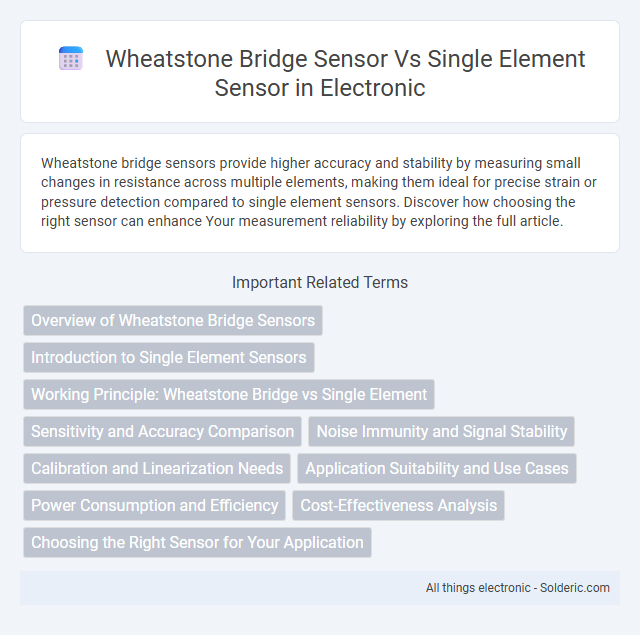Wheatstone bridge sensors provide higher accuracy and stability by measuring small changes in resistance across multiple elements, making them ideal for precise strain or pressure detection compared to single element sensors. Discover how choosing the right sensor can enhance Your measurement reliability by exploring the full article.
Comparison Table
| Feature | Wheatstone Bridge Sensor | Single Element Sensor |
|---|---|---|
| Configuration | Four resistive elements arranged in a bridge circuit | Single resistive or active sensing element |
| Sensitivity | High, due to differential measurement | Lower, single output signal |
| Noise Rejection | Excellent common-mode noise rejection | Poor noise rejection, more susceptible |
| Output Signal | Differential voltage directly proportional to sensed variable | Single-ended voltage or current |
| Temperature Compensation | Built-in, due to bridge symmetry | Requires external compensation |
| Complexity | More complex circuitry required | Simpler design and implementation |
| Applications | Strain gauges, pressure sensors, precision measurements | Basic detection, simple sensing tasks |
Overview of Wheatstone Bridge Sensors
Wheatstone bridge sensors consist of four resistive elements arranged in a diamond shape to accurately measure small changes in resistance, improving sensitivity and temperature compensation. These sensors provide precise and stable output signals by balancing the bridge circuit, making them ideal for strain gauge and pressure sensor applications. Your sensing system benefits from enhanced accuracy and noise reduction compared to single element sensors, which rely on a solitary resistive element without inherent compensation features.
Introduction to Single Element Sensors
Single element sensors utilize one sensing element to measure physical quantities such as pressure, temperature, or force, providing straightforward signal output. These sensors typically offer simplicity and cost-effectiveness but may be more susceptible to noise and environmental variations. In contrast, Wheatstone bridge sensors incorporate multiple resistive elements configured to enhance sensitivity and compensate for temperature fluctuations, improving measurement accuracy.
Working Principle: Wheatstone Bridge vs Single Element
The Wheatstone bridge sensor operates by measuring the differential change in resistance across four resistive arms arranged in a bridge circuit, allowing precise detection of small variations caused by physical changes such as strain or temperature. In contrast, a single element sensor relies on the resistance change of a solitary resistive element, providing less sensitivity and more susceptibility to environmental factors. Your choice of sensor impacts measurement accuracy, with Wheatstone bridge configurations offering enhanced stability and noise reduction over single element sensors.
Sensitivity and Accuracy Comparison
Wheatstone bridge sensors provide higher sensitivity and accuracy compared to single element sensors by effectively minimizing temperature drift and strain. The balanced configuration of the Wheatstone bridge enables precise detection of small resistance changes, improving signal stability and resolution. Single element sensors often suffer from lower sensitivity due to baseline shifts and limited compensation for environmental variations.
Noise Immunity and Signal Stability
Wheatstone bridge sensors offer superior noise immunity by balancing and canceling out common-mode interference, which significantly enhances signal stability in demanding environments. Single element sensors are more susceptible to external noise and signal fluctuations due to their unbalanced circuitry, often resulting in less reliable readings. Your choice of sensor impacts measurement accuracy, with Wheatstone bridge configurations being preferable for consistent and precise data in electrically noisy conditions.
Calibration and Linearization Needs
Wheatstone bridge sensors require less frequent calibration due to their inherent temperature compensation and balanced circuit design, which enhances signal stability. Single element sensors need more regular calibration to correct for drift and environmental variations affecting accuracy. Your choice impacts maintenance efforts, as bridge configurations simplify linearization and improve overall measurement reliability compared to single element sensors.
Application Suitability and Use Cases
Wheatstone bridge sensors provide enhanced accuracy and temperature compensation, making them ideal for precision measurements in industrial weighing, strain gauge applications, and structural health monitoring. Single element sensors, while simpler and cost-effective, are better suited for basic pressure or force detection where high precision is not critical. Your choice depends on whether you require complex data accuracy for advanced applications or straightforward measurements for routine monitoring.
Power Consumption and Efficiency
Wheatstone bridge sensors generally consume more power than single element sensors due to their multiple resistor elements, but this design enhances measurement accuracy and signal stability. Single element sensors offer lower power consumption, making them ideal for battery-powered or energy-sensitive applications, though they may sacrifice some precision. Efficiency improvements in Wheatstone bridge sensors often stem from optimized resistor materials and integrated circuit designs that balance power use with high sensitivity.
Cost-Effectiveness Analysis
Wheatstone bridge sensors generally offer higher accuracy and sensitivity by measuring resistance changes through multiple resistive elements configured in a bridge circuit, which can increase initial costs compared to single element sensors. Single element sensors tend to be more cost-effective for applications with less stringent precision requirements, due to their simpler design and lower manufacturing expenses. When evaluating cost-effectiveness, consider Your specific application's accuracy needs against budget constraints, as Wheatstone bridge sensors may provide long-term value through improved data reliability despite higher upfront investment.
Choosing the Right Sensor for Your Application
Wheatstone bridge sensors offer enhanced accuracy and sensitivity by measuring resistance changes across multiple elements, making them ideal for applications requiring precise strain or pressure measurement. Single element sensors provide simplicity and lower cost, suitable for less demanding environments or where only basic detection is needed. Selecting the right sensor depends on factors such as measurement precision, environmental conditions, and budget constraints, ensuring optimal performance for specific industrial or research applications.
Wheatstone bridge sensor vs single element sensor Infographic

 solderic.com
solderic.com